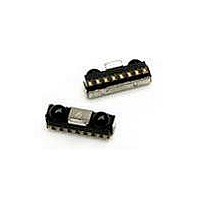HSDL-3021-021 Lite-On Electronics, HSDL-3021-021 Datasheet - Page 22

HSDL-3021-021
Manufacturer Part Number
HSDL-3021-021
Description
Infrared Transceivers IR Transceiver 4.0Mb/s
Manufacturer
Lite-On Electronics
Datasheet
1.HSDL-3021-021.pdf
(24 pages)
Specifications of HSDL-3021-021
Wavelength
885 nm
Continual Data Transmission
4 Mbit/s
Transmission Distance
50 cm
Radiant Intensity
10 mW/sr
Half Intensity Angle Degrees
30 deg to 60 deg
Pulse Width
4 us, 1.6 us
Maximum Rise Time
40 ns, 600 ns
Maximum Fall Time
40 ns, 600 ns
Led Supply Voltage
0 V to 6.5 V
Operating Voltage
2.4 V to 3.6 V
Maximum Operating Temperature
+ 85 C
Minimum Operating Temperature
- 25 C
Dimensions
8 mm x 3 mm x 2.5 mm
Lead Free Status / RoHS Status
Lead free / RoHS Compliant
Available stocks
Company
Part Number
Manufacturer
Quantity
Price
Company:
Part Number:
HSDL-3021-021
Manufacturer:
Agilent
Quantity:
1
Part Number:
HSDL-3021-021
Manufacturer:
AVAGO/安华高
Quantity:
20 000
Company:
Part Number:
HSDL-3021-021/HSDL3021
Manufacturer:
Agilent
Quantity:
10 000
Window Material
Almost any plastic material will work as a window mate-
rial. Polycarbonate is recommended. The surface finish
of the plastic should be smooth, without any texture. An
IR filter dye may be used in the window to make it look
black to the eye, but the total optical loss of the window
should be 10% or less for best optical performance. Light
loss should be measured at 875 nm. The recommended
plastic materials for use as a cosmetic window are avail-
able from General Electric Plastics.
Recommended Plastic Materials:
Material #
Lexan 141
Lexan 920A
Lexan 940A
Note: 920A and 940A are more flame retardant than 141.
Recommended Dye: Violet #21051 (IR transmissant above 625 mm)
Flat Window
(First Choice)
22
Light
Transmission
88%
85%
85%
Haze
1%
1%
1%
Curved Front and Back
(Second Choice)
Refractive
Index
1.586
1.586
1.586
Shape of the Window
From an optics standpoint, the window should be flat.
This ensures that the window will not alter either the ra-
diation pattern of the LED, or the receive pattern of the
photodiode. If the window must be curved for mechani-
cal or industrial design reasons, place the same curve on
the backside of the window that has an identical radius
as the front side. While this will not completely elimi-
nate the lens effect of the front curved surface, it will
significantly reduce the effects. The amount of change
in the radiation pattern is dependent upon the material
chosen for the window, the radius of the front and back
curves, and the distance from the back surface to the
transceiver. Once these items are known, a lens design
can be made which will eliminate the effect of the front
surface curve. The following drawings show the effects
of a curved window on the radiation pattern. In all cases,
the center thickness of the window is 1.5 mm, the win-
dow is made of polycarbonate plastic, and the distance
from the transceiver to the back surface of the window
is 3 mm.
Curved Front, Flat Back
(Do not use)














